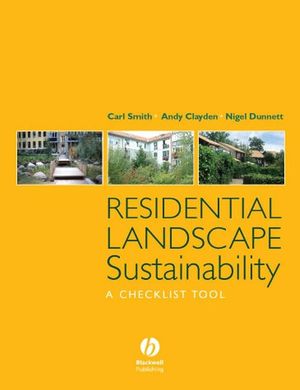Residential Landscape Sustainability: A Checklist ToolISBN: 978-1-4051-5873-2
Hardcover
208 pages
October 2007, Wiley-Blackwell
 |
||||||
IntrodutionDefinitions of sustainable development and sustainable landscape Sustainable development.
Sustainable landscape.
Sustainable development in English planning and development The key role of housing in sustainable development Current concepts and initiatives for delivering sustainable homes in England.
Urban Villages and Millennium Communities BREEAM certified housing.
What impact have these initiatives had on delivering sustainable residential Communities? Chapter Two: Opportunities for improving the Sustainable profile of new residential developments.
Conservation of resources and minimisation of pollution and waste Energy consumption and microclimate control.
The greenhouse effect and energy consumption in the home.
Providing wind shelterProviding solar access and shade.
Encouraging walking and cycling.
Impacts of car use Design of transport routes.
Specification and detailed design of hard landscape materials.
Embodied energy and Life Cycle Assessment (LCA) of hard materials Timber sourcing Timber treatment and detailing Relatively sustainable plastic and metal Relatively sustainable non-metal mineral products Lean construction and recovered materials.
(Specification and detailed design of soft landscape materials - Vegetation.
Life cycle assessment (LCA) of Vegetation Plant production and nursery practices Planting design, implementation and maintenance.
Plant Palette and Planting Style.
Size of Plant Material.
Site conditions and preparation.
Integration of existing, established planting.
Prohibition of synthetic chemical use for on-site landscape works.
Water management.
Reduced domestic water consumption Management of surface water runoff.
Pollution and Flooding.
Amenity and habitat.
Sustainable Urban Drainage Systems (SuDs).
Enhancement of site ecological function and human well-being.
Site ecological function Preserving and encouraging biodiversity Key aspects of ecological landscape design and management.
Protecting existing ecological capital.
Opportunities for improving diversity and ecological networks Plant origins; natives, non-natives and provenance.
Providing for the health and well-being of residents.
Private and communal space.
Loss of existing Gardens.
Communal SpacesPotential social benefits of trees. Ways of improving the acceptance of sustainable vegetation in the residential landscape.
Chapter Three: Creating a Residential Landscape Sustainability Checklist.
A review of sustainable checklist tools for residential development A detailed description of the template BRE EcoHomes method Adapting the EcoHomes method for landscape assessments.
The Energy Category.
The Transport Category.
The Pollution Category.
The Materials Category.
The Water Category.
The Ecology and Land Use Category.
The Health and Well-Being CategoryAdjusting the EcoHomes weighting factors.
Setting compliance standardsJudging visual qualities.
General limitations of the checklist assessment approach.
.
Chapter Four: Case Studies: Applying the Residential Landscape Checklist.
Introduction.
Greenwich Millennium Village, London.
Childwall, Liverpool.
Evaluation of the Case studies against the Sustainable Landscape Checklist.
The Energy Category.
Microclimatic Landscape design.
The Transport Category.
Layout and design of pedestrian and cycle routes.
Traffic calming.
The Pollution Category.
Reduced use of timber treatments.
Reducing Site Run off through green space provision.
Use of reclaimed metal, concrete and bricks and recycled plastic.
On-site control of chemical applications.
Nursery practices.
Reduced Site run-off through Sustainable Urban Drainage (SuDs).The Materials Category.
Timber sources and treatments.
Reduced impact metal elements.
Use of reclaimed or recycled stone and aggregate.
Transport energy.
Hardworks Detailing.
Softworks Planting Design and Establishment.
Softworks preparation and implementation.
Environmental profile of materialsThe Water Category The Ecology and Land Use Category.
Conservation of existing landscape features.
Vegetative diversity and connectivity.
Conflicting land use.
Artificial habitat features.
The Health and Well-Being Category.
Provision of private and communal space.
Garden privacy.
Facilitating children’s play in communal spaces.
Opportunities for planting and food production.
Design cues, labels of care and improving acceptance of ecological plantings.
Embedded tree cover.
What factors encouraged and discouraged residential landscape sustainability.
Those factors which contribute to delivering Residential Landscape Sustainability.
Sustainable Landscape Design Brief and the early appointment of a Landscape Architect.
Those factors which may undermine landscape sustainability.
The cost and difficulty in sourcing and specifying reclaimed materials.
The Influence of Social Context and Tenure.
Creating space for plants and trees.
Issues related to adoption and maintenance discouraged landscape sustainability.
Conclusion.
Bibliography.
Appendices: Detailed Residential Landscape Checklist.



